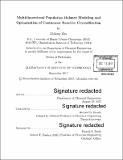Multidimensional population balance modeling and optimization of continuous reactive crystallization
Author(s)
Zhu, Zhilong, Ph. D. Massachusetts Institute of Technology
DownloadFull printable version (13.97Mb)
Other Contributors
Massachusetts Institute of Technology. Department of Chemical Engineering.
Advisor
Richard D. Braatz.
Terms of use
Metadata
Show full item recordAbstract
Phosphoric acid is the primary ingredient for almost all the phosphorous based fertilizer used in agriculture around the world. During the production of phosphoric acid, phosphate rock is reacted with sulfuric acid producing gypsum as the byproduct that is separated from the phosphoric acid by filtration. The efficiency of filtration depends strongly on the crystal size distribution (CSD) and shape. Undesired gypsum CSD and shape not only prolong the filtration and bottleneck the plant's overall production, but also decrease the phosphate recovery from the wet cake. To optimize the process, a first-principle process model is developed for the reactor-crystallizer to predict CSD and shape, and subsequently the filtration rate. This thesis presents a multidimensional population balance model (PBM) framework that models CSD with two independent characteristic lengths or 2D PBM. Compare with the 1D PBM, the extra characteristic length in the 2D PBM provides enough degrees of freedom to model needle-, plate-, and rod-like crystals that exhibits varying aspect ratio. The applicability of the 2D PBM for continuous crystallization is made possible by introducing growth rate dispersion mechanism that accounts for the broadening of the size distribution from the measured 2D CSD. Computationally efficient and highly resolved numerical methods are developed for solving both dynamic and steady-state 2D PBM that consists of integro-partial differential equation. Maximum likelihood estimation method is used for the first time to estimate crystal kinetics from the measured 2D CSD and shows much more accurate estimation than the established moment approach. The supersaturation in the multicomponents aqueous solution is defined based on chemical potential and is modeled by a speciation based mixed-solvent-electrolyte thermodynamic model. The effect of metal ion impurity on crystal growth rate and nucleation rate is modeled based on the crystal kinetics determined for the crystallizing system without impurity. All individual model components developed are validated and integrated to predict the effect of temperature, residence time, acid composition, and metal ion impurity concentration on the CSD and shape. The predicted CSD and shape are used as input for the filtration model that quantifies cake filterability. Finally, steady-state process optimization is formulated for maximum phosphoric acid production rate.
Description
Thesis: Ph. D., Massachusetts Institute of Technology, Department of Chemical Engineering, 2017. Cataloged from PDF version of thesis. Includes bibliographical references (pages 147-155).
Date issued
2017Department
Massachusetts Institute of Technology. Department of Chemical EngineeringPublisher
Massachusetts Institute of Technology
Keywords
Chemical Engineering.